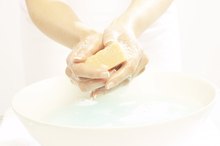Boils & Pain Relief
A boil is a painful swelling that grows from beneath your skin. In many cases, you can employ home treatments or even alternative remedies to treat boils, but they’re sometimes so painful or severe that you have to undergo certain convention medical treatments. Before you try to relieve your boil pain at home, consult your doctor for a proper diagnosis and an explanation of safe but effective treatment options.
Identification
Boils typically look like swollen red bumps that resemble large pimples. Boils occur when a hair follicle becomes infected and forms an abscess filled with pus. Boils most commonly occur in your armpits, groin and neck or on your buttocks, thighs or face. Boils can be extremely painful, depending on their location and size. At some point, usually within two weeks, a boil typically ruptures and the pus drains out.
- Boils typically look like swollen red bumps that resemble large pimples.
- At some point, usually within two weeks, a boil typically ruptures and the pus drains out.
Types
Boils on Buttocks and Thighs
Learn More
There are four main types of boils, the most common of which are furuncles or carbuncles. Furuncles and carbuncles arise from a bacteria infection, usually due to the bacteria Streptococcus pyogenes or Staphylococcus aureus 23. If you have a cluster of furuncle boils, this is known as a carbuncle. Another type of boil is known as a pilonidal cyst, which involves an abscess on the buttocks. Other types include cystic acne that are most common in teenagers due to infected and blocked oil ducts, and hidradenitis suppurativa that occurs rarely in clusters of abscesses in the groin and armpits.
- There are four main types of boils, the most common of which are furuncles or carbuncles.
- Another type of boil is known as a pilonidal cyst, which involves an abscess on the buttocks.
Prevention/Solution
One of the most common treatments to relieve pain from boils involves lancing and draining the abscess. This treatment involves cutting into the tip of the boil and draining the pus, but it’s usually reserved for large, persistent or severe boils. To ease pain and clear up the infection, your doctor might have you keep gauze over the lanced boil and take antibiotics.
If you have diabetes, a suppressed immune system or a tendency to get chronic boils, you may need to take some preventive measures as well. To prevent recurring boils, avoid tight-fitting clothing, keep your skin clean at all times and use antibacterial soap, and thoroughly clean or treat any cuts, scrapes or minor wounds. Frequent hand-washing and other general hygiene practices can reduce your chances of contracting or spreading a bacterial infection as well.
- One of the most common treatments to relieve pain from boils involves lancing and draining the abscess.
- This treatment involves cutting into the tip of the boil and draining the pus, but it’s usually reserved for large, persistent or severe boils.
Considerations
How to Cure Boils & Pus
Learn More
In many cases, you can take care of boils at home. Home remedies for boils typically include applying warm compresses to the affected area three to four times daily for about 20 minutes at a time. Keeping the boil and the area around it clean using antibacterial soap at least twice daily and covering it with a bandage can also help heal the boil.
These practices can encourage the boil to “come to a head” and begin to drain. Continue to clean the boil and apply warm compresses to it for about three days after it begins to drain. You can also try certain alternative remedies to treat your boil, such as applying tea tree oil. Tea tree oil can help ease your pain, promote healing and fight the bacterial infection. Don’t try any home or alternative remedy to treat boils before first discussing them with your physician.
- In many cases, you can take care of boils at home.
- Keeping the boil and the area around it clean using antibacterial soap at least twice daily and covering it with a bandage can also help heal the boil.
Warning
Don’t attempt to treat a boil on your own if you have severe pain, a fever, red streaks extending from the boil, diabetes or multiple boils. You should also see your doctor right away if your boil doesn’t resolve within two weeks or fails to get better after one week of home treatment. Boils that continue to grow to larger than a ping-pong ball and boils located near your anus, close to your spine or on your face should be treated by a healthcare professional.
If your boil becomes progressively worse or more painful, or if the boil refuses to drain, you should see your doctor. In rare cases, a boil can lead to sepsis when the bacterial infection spreads from the boil into your blood stream, causing blood poisoning. In other cases, your boil could involve the drug-resistant bacterial strain of Staphylococcus aureus, known as methicillin-resistant Staphylococcus aureus – MRSA 3.
- Don’t attempt to treat a boil on your own if you have severe pain, a fever, red streaks extending from the boil, diabetes or multiple boils.
Related Articles
References
- Clinical, Cosmetic and Investigational Dermatology: Recurrent Furunculosis -- Challenges and Management -- A Review
- European Journal of Clinical Microbiology & Infectious Diseases: Antibody Responses in Furunculosis Patients Vaccinated with Autologous Formalin-Killed Staphylococcus Aureus
- Journal of Clinical Microbiology: Association of Recurrent Furunculosis with Panton-Valentine Leukocidin and the Genetic Background of Staphylococcus Aureus
- Ibler KS, Kromann CB. Recurrent furunculosis - challenges and management: a review. Clin Cosmet Investig Dermatol. 2014;7:59-64. doi:10.2147/CCID.S35302
- Cleveland Clinic. Boils & carbuncles. Reviewed April 15, 2016
Writer Bio
Sarah Terry brings over 10 years of experience writing novels, business-to-business newsletters and a plethora of how-to articles. Terry has written articles and publications for a wide range of markets and subject matters, including Medicine & Health, Eli Financial, Dartnell Publications and Eli Journals.







